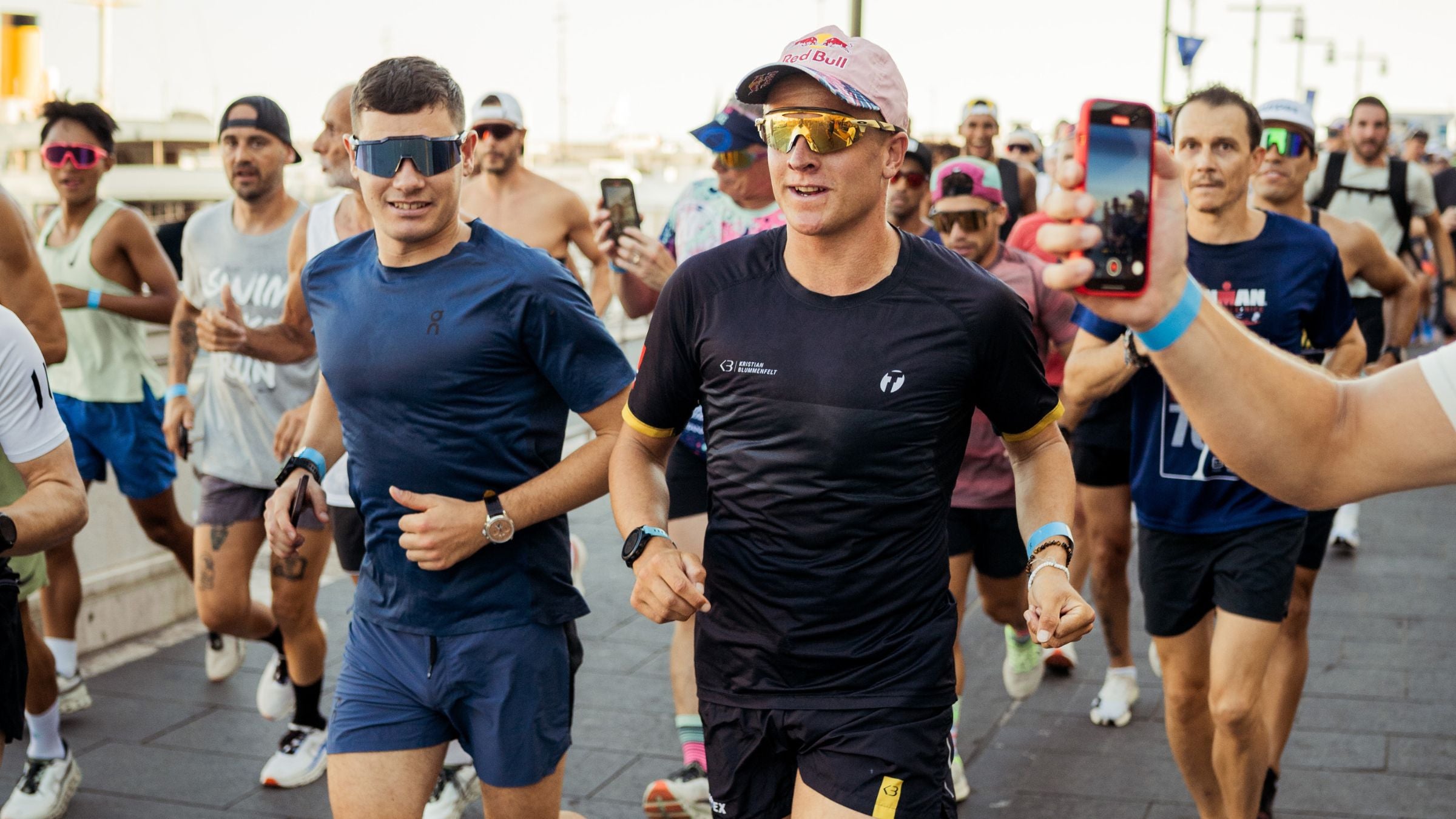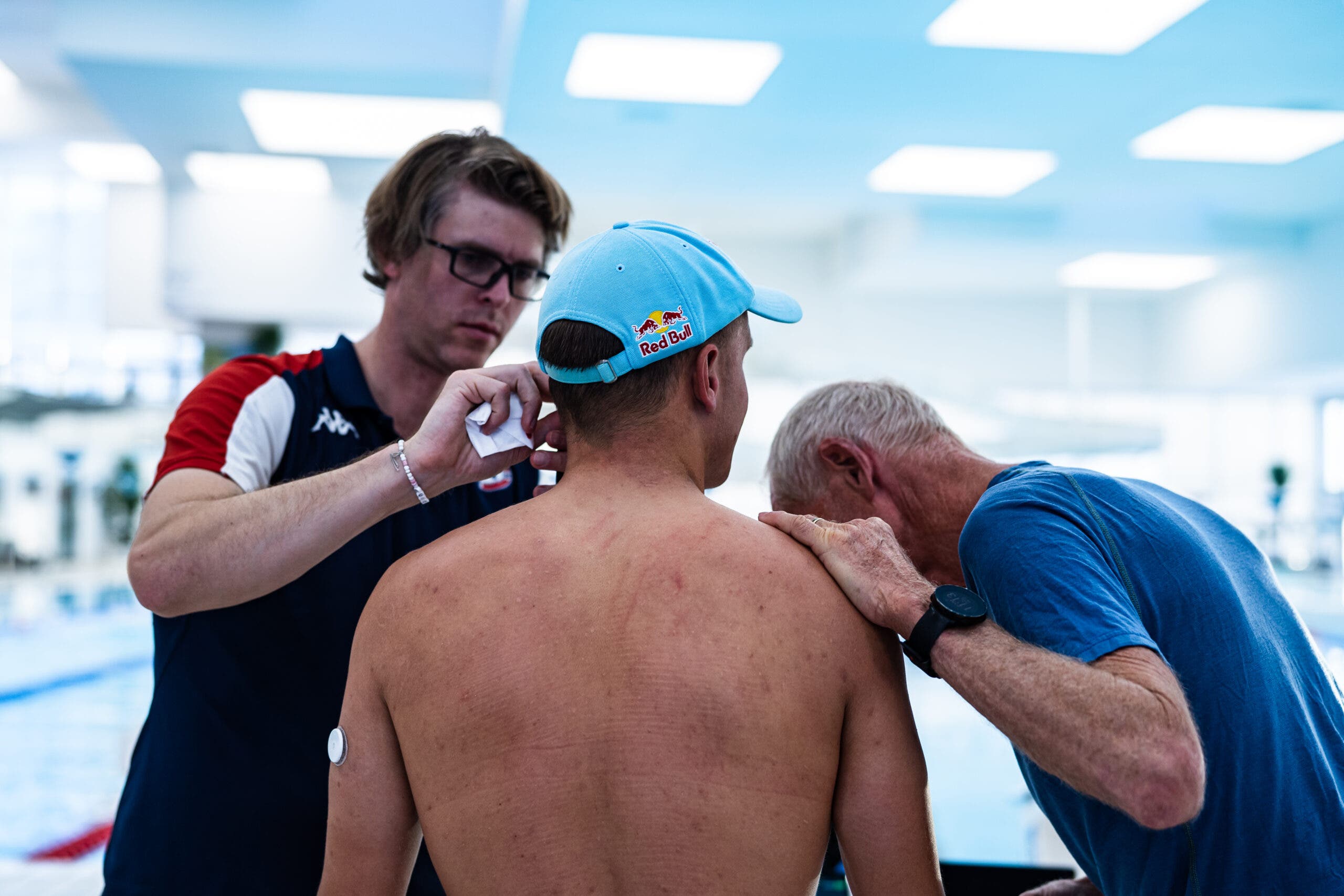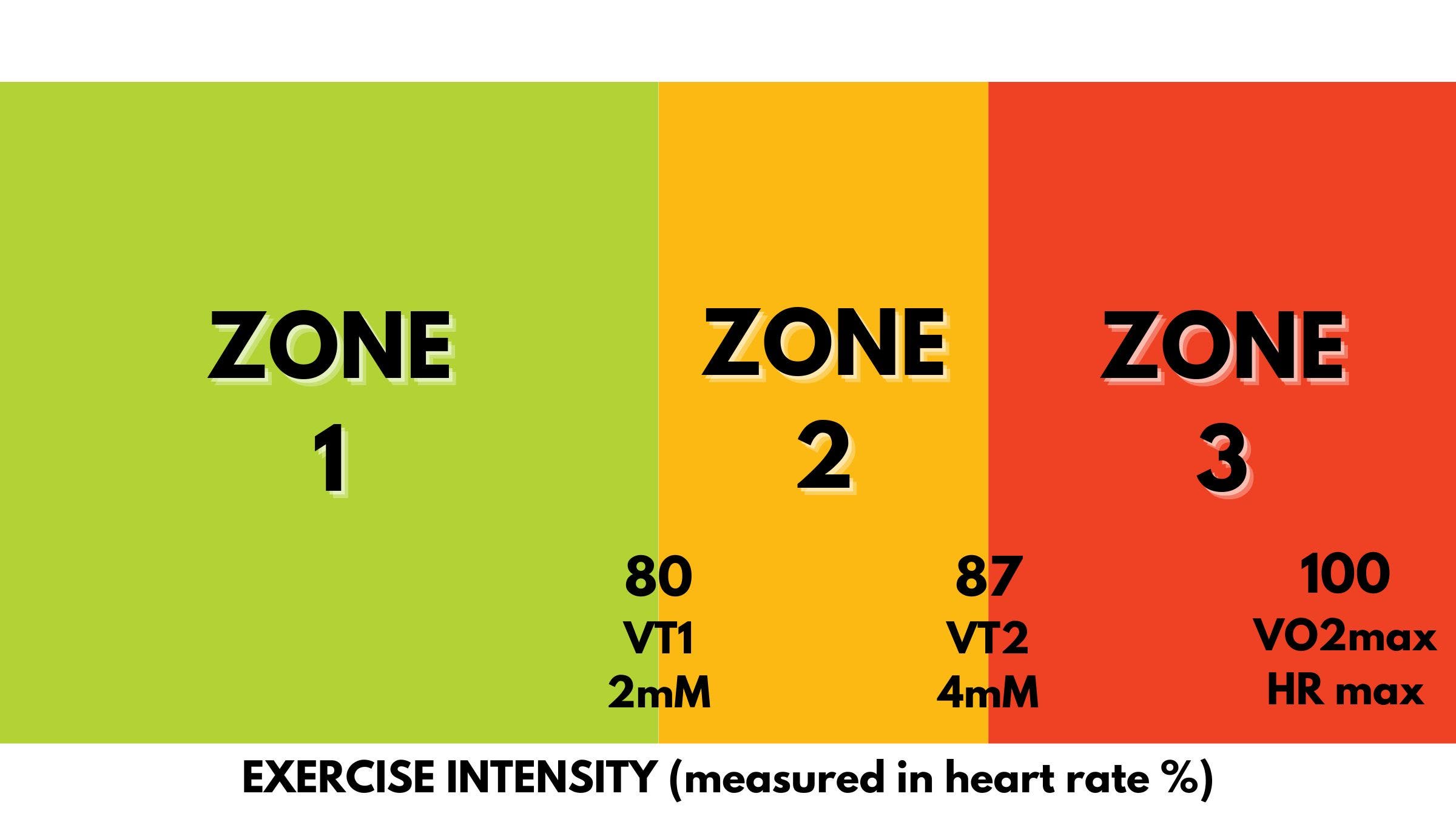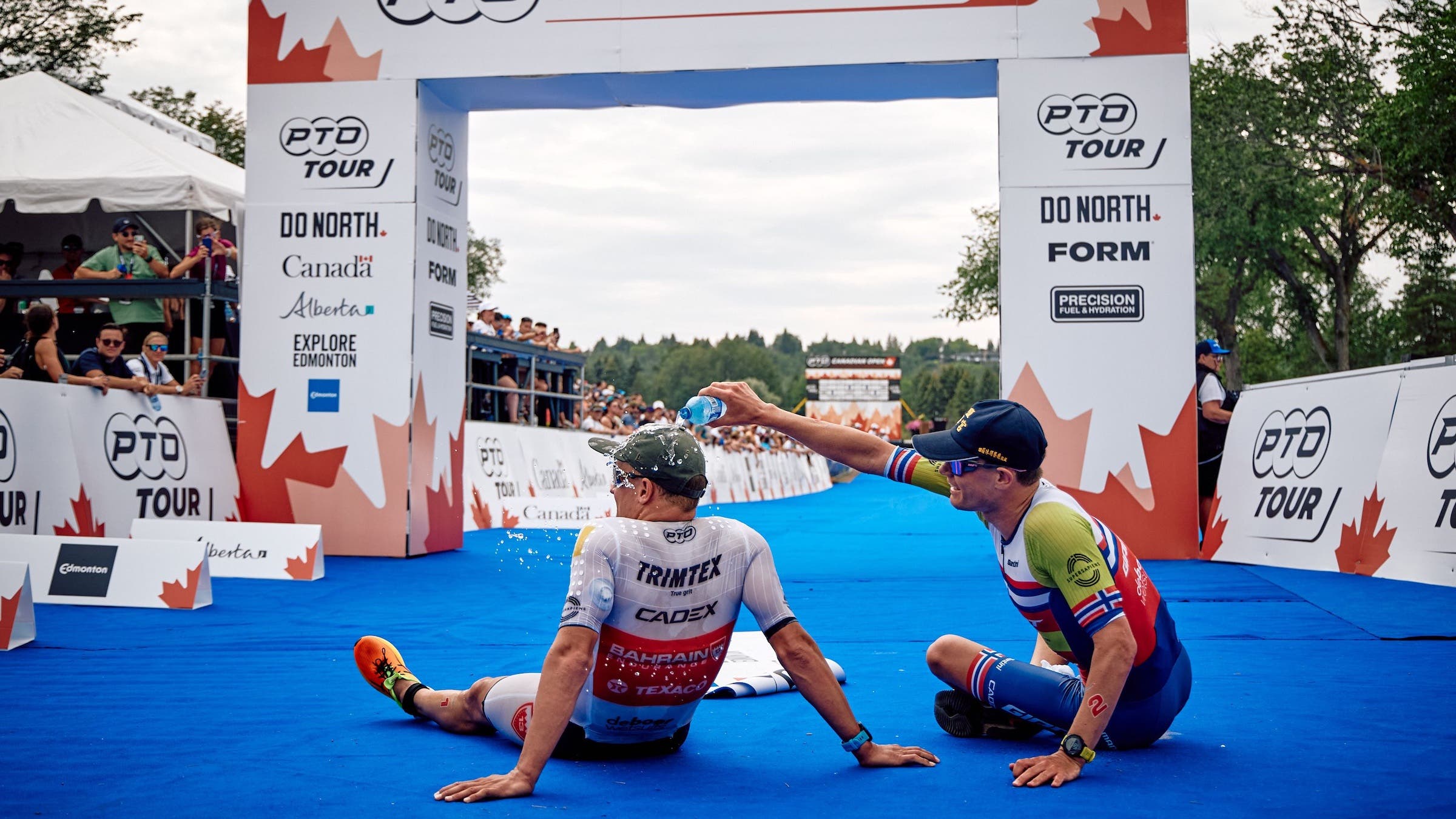How to Train Like A Norwegian (Without The Blood)

Gustav Iden (L) and Kristian Blummenfelt (R) on a group training run in France. (Photo: Simon Gehr/On Running)
Table of Contents
Imagine yourself pulling over to the side of the road, grabbing a blood lactate meter out of your back pocket, and pricking yourself in the finger five times every interval session. Is this the essence of the Norwegian Method? Well, not really.
Norwegian endurance athletes have entered a golden era of record-setting performances. Olympic triathlon champion Kristian Blummenfelt and Ironman world champion Gustav Iden are at the head of the tri world, while Olympic 1500-meter champion Jakob and the Ingebrigtsen brothers have found equal levels of success on the track.
Olav Aleksander Bu, Blummenfelt and Iden’s coach, has discussed the Norwegian Method of training in deep and revealing interviews. Thousands of athletes have tried the methods themselves, but most end up confused and flailing. We’ve watched, read, and listened to every single piece of Norwegian Method content so that we can explain, translate, distill, and deliver the Norwegian Method to everyday triathletes.
In this article, we’re going to explain the Norwegian Method, how it works, and how you can apply the spirit of the Norwegian Method to your own training. At the end of this piece, we’ll give you a three-week “Norwegian-style Training Plan” that could help bring your fitness to the next level (without the blood).
The Norwegian Method: Explained

Way back in 1998, the Norwegian Athletics Federation began using lactate meters to monitor and control running intensity, according to former 5000-meter runner Marius Bakken. This article lays out what Bakken called, not-so-succinctly, “The Norwegian model of lactate threshold training and lactate controlled approach to training.”
Over the years, the Norwegian Method has developed into much more than mid-run-workout lactate measurements. Nowadays, there are a few key tenets to the Norwegian Method of endurance training.
| High-volume, low intensity training | 30 hours per week seems to be the standard for Blummenfelt, who shares his training data on Strava. The longest training weeks can be 35-40 hours, with 80-90% of the sessions completed at a low intensity (which we’ll discuss in detail, below). |
| Double threshold days | As simple as it sounds, a double threshold day is two high-intensity training sessions in one day – one in the morning and one in the evening. The high-intensity work includes moderate and hard intervals, but the intensity might not be as high as you think. |
| Lactate-controled intensities | Perhaps the most infamous aspect of the Norwegian Method is the constant finger-pricking that is required to test blood lactate during training. Athletes will stop their swim, bike, or run workouts multiple times in a single session in order to get a lactate reading, ensuring that their body is working at precisely the correct intensity. |
The funny thing is that each of these tenets are surprisingly simple. Stick to the plan, complete each workout, measure your lactate, and you’ll become an Olympic champion, right?
If it was that easy, everyone would do it.
The high-volume training and strict intensity discipline are often cited as the reasons athletes quit using the Norwegian Method. Watch any piece of content where Blummenfelt or Ingebrigsten is talking about their training, and you can tell the monotonous training can be boring. But they know it works for them – and that’s why they are two of the best endurance athletes in history.
Why the Norwegian Method Uses Lactate to Measure Training Intensity
Precise training intensity is the why behind the Norwegian Method. The operating assumption is that blood lactate is a better measurement of intensity than heart rate, power, or rate of perceived exertion (RPE).
Unfortunately, there isn’t an objective truth as to which measurement is best because what works well for one athlete may not work for another. But the Norwegian Method works for many, and this is why…
The Norwegian Method uses a pyramidal training approach rather than a polarized one.
In short, polarized is the most popular training approach in modern triathlon, and it is defined by easy sessions and hard sessions. In a polarized training plan, about 80% of training sessions are completed at a low intensity and the remaining 20% of training sessions are completed at a high intensity—you’ll also hear this called, unsurprisingly, the 80/20 method.
In contrast, a pyramidal training plan includes a massive amount of low intensity training, a moderate amount of medium-hard training, and a small amount of high-intensity training.
Furthermore, easy, medium, and hard training – according to the Norwegian Method – is defined by LT1 and LT2 (which we’ll define below). Exercise physiologist and endurance coach Alan Couzens says, “The Norwegians…do a lot of work in the middle of the intensity range, between their two thresholds, known as Lactate Threshold 1 (LT1) and Lactate Threshold 2 (LT2)”:
| LT1 ("Aerobic Threshold" | This is the point at which your body switches from aerobic metabolism to a mix of aerobic and anaerobic metabolism, clearing lactate at a slower rate due to the increased intensity. Below LT1 are your easy training Zones 1 and 2. For most athletes, LT1 occurs at a lactate level of roughly 2 mmol, or 80% of maximum heart rate (HRmax). |
| LT2 ("Anaerobic Threshold") | This is when your body begins to produce lactate at an unsustainable rate. Just below LT2 is the intensity that you can hold for roughly an hour, or longer for well-trained endurance athletes. For most, LT2 occurs around 4 mmol, or 87% of HRmax. But again, these numbers can vary substantially between athletes. |
In other words:
Below LT1 = easy intensity
Between LT1 and LT2 = medium (“Norwegian threshold”) intensity
Above LT2 = hard intensity

The secret to the Norwegian Method is executing high-quality training sessions between LT1 and LT2. This is also known as Zone 3 in the five-zone training model. Norwegians call these “threshold” sessions, but many others would call this “tempo.”
Polarized training models avoid “Norwegian threshold” sessions as much as possible, while the pyramidal Norwegian Method focuses many hours of training time at this carefully measured intensity.
Should Amateur Triathletes Try the Norwegian Method?
Yes, you can try the Norwegian Method at home, and you don’t even need a lactate meter. In fact, Coach Aleksander Bu has explained how everyday triathletes can channel the essence of the Norwegian Method into their training.
Last year, Triathlete tackled the full “Norwegian experiment,” subjecting Emma-Kate Lidbury to more than nine weeks of Norwegian Method training. You can read about what happened to her in this article.
First, let’s remind ourselves of the Norwegian Method’s three key tenets:
- High-volume, low-intensity training
- Double threshold days
- Lactate-controlled intensities
The first two are fairly easy to implement into your training program – at the end of this article, we have a three-week Norwegian Block that you can try for yourself. There, you can see exactly when and how to include double-threshold days into your high-volume, low-intensity training plan.
But alas, we are still missing the lactate-controlled intensities. Well, the secret here is that you don’t need a lactate meter to control your training intensity. We already have three alternative ways to do that: heart rate, power, and RPE.
A Practical Approach to the Norwegian Method

The training methods we’ll discuss next are not the Norwegian Method. Instead, they are the “spirit of the Norwegian Method” – we’ll call it the Norwegian Method Lite – adapted for everyday triathletes. Perfect execution of the Norwegian Method requires upwards of 35 hours of training per week, thousands of lactate measurements, expert, hands-on coaching, and years of experience to avoid injury and burnout.
Designed for everyday people like you and me, the Norwegian Method Lite is based on heart rate (HR), power, and RPE. Here is a quick reminder of what each metric means and how it is measured:
| Heart Rate | You can measure your HR with a variety of chest straps, wristwatches, or optical sensors. LT1 typically occurs around 78–80% HRmax, and LT2 occurs at roughly 87–90% HRmax. |
| Power | Measured on the bike or your running shoes, power is an external output measurement rather than an internal gauge of how hard your body is working. LT1 typically occurs around 65-75% of your functional threshold power (FTP), and LT2 occurs at roughly 98–103% of your FTP. |
| RPE (rate of perceived exertion) | The easiest and cheapest metric in all of endurance sports – RPE asks the question, “How hard are you working?” On a scale of 1 to 10, exercising at LT1 is an RPE of 3–4 for most athletes, while LT2 is much harder at an RPE of 6–7. |
If you’re new to triathlon, HR and RPE are the best metrics to start with. We recommend doing a threshold test to establish your training zones, detailed in this article.
Once your training zones are established, you need to learn how to use them; this article can help. Your zones will help guide your training intensities, avoid injury, and prevent burnout. From complete beginners to experienced professionals, it is crucial to understand and utilize your training zones.
The Norwegian Method Lite follows the principles of the Norwegian Method, but instead of interrupting your workouts with lactate measurements, you track your intensity using HR, power, or RPE. One of the most crucial aspects of the Norwegian Method Lite is using HR, power, or RPE for strict intensity discipline.
Examples:
If you’re LT1 HR is 145 bpm, for example, then your easy sessions should be completed at about 140 bpm. Don’t surge on hills or accelerate hard after a stop sign. If it’s hot and your core temperature is higher, then you need to train slower in order to keep your HR below LT1. There’s no room for being a “workout hero.”
The whole point is to measure how hard your body is working, not how fast you are going.
The same principles apply to the bike. If you are doing a Norwegian Threshold session (between LT1 and LT2) at 88% of your FTP, stick to that number religiously. Avoid sprinting out or corners or coasting down a five-minute descent. This is part of the reason so many athletes, Blummenfelt and Ingebrigsten included, prefer to do their training sessions indoors in a controlled, distraction-free environment.
This is also one of the biggest complaints about the Norwegian Method—that it can take the fun out of training. And they’re right – strict discipline takes away your freedom to go as hard or as easy as you want.
However, the belief is that the Norwegian Method maximizes your fitness gains by increasing the amount of intense work you can do without compromising your recovery.
Why a Triathlete Should (or Shouldn’t) Use the Norwegian Method
Clearly, the Norwegian Method is not for everyone. It is specifically designed for the top 1% of endurance athletes who have 30+ hours per week to train and professional support systems behind them.
An amateur triathlete with eight hours of training per week, for example, will not benefit as much from the Norwegian method as a professional triathlete with unlimited weekly training time.
Triathletes with limited training time should maximize their training through high-quality sessions, controlled intensities, and consistent volume. Interrupting your workout to prick your finger will only – maybe – benefit some of the top endurance athletes in the world. Professional athletes also have nearly unlimited time for proper recovery, while many everyday triathletes have jobs, kids, and other daily obligations.
How to Add the “Norwegian Method Lite” to Your Training Plan
Let’s put it all together: the high-volume, double-threshold, controlled-intensity training plan. Or the short version: Norwegian Method Lite.
You can add this three-week training block to your calendar for a physical and mental boost. Whether it’s the off-season or the peak of the summer, this training block is designed to raise your fitness through structured workouts and carefully prescribed rest periods.
Norwegian Method Lite Key:
- “Easy” session: below LT1
- Threshold: between LT1 and LT2
- 2-4 mmol
- 80–87% HRmax
- 80–90% FTP
- 4–6 out of 10 RPE
- Medium Threshold
- 2–3 mmol
- 80–84% HRmax
- 80–85% FTP
- 4–5 out of 10 RPE
- Hard Threshold
- 3-4 mmol
- 85–87% HRmax
- 86–90% FTP
- 5–6 out of 10 RPE
A 3-Week Norwegian Triathlon Training Plan
Week 1
| Monday | AM: 45 minutes easy swim PM: 90 minutes easy bike |
| Tuesday | AM: 5x5 minutes run at medium Threshold with 1-minute recovery PM: 10x2 minutes run at hard Threshold with 1-minute recovery |
| Wednesday | AM: 45 minutes easy swim PM: 45 minutes strength training |
| Thursday | AM: 4x10 minutes bike at medium Threshold with 5-minute recovery PM: 10x1 minute bike at hard Threshold with 1-minute recovery |
| Friday | 90 minutes easy bike |
| Saturday | 20x30 seconds run at hard Threshold with 1-minute recovery |
| Sunday | 3 hours easy bike |
Week 2
| Monday | AM: 45 minutes easy swim PM: 90 minutes easy bike |
| Tuesday | AM: 5x5 minutes run at medium Threshold with 1-minute recovery PM: 20x1 minute run at hard Threshold with 30-second recovery |
| Wednesday | AM: 45 minutes easy swim PM: 45 minutes strength training |
| Thursday | AM: 3x15 minutes bike at medium Threshold with 10-minute recovery PM: 20x30 seconds bike at hard Threshold with 30-second recovery |
| Friday | 60 minutes easy run |
| Saturday | 20x45 seconds run at hard Threshold with 1-minute recovery |
| Sunday | 3.5 hours easy bike |
Week 3
| Monday | AM: 45 minutes easy swim PM: 90 minutes easy bike |
| Tuesday | AM: 4x6 minutes run at medium Threshold with 1-minute recovery PM: 20x1 minute run at hard Threshold with 30-second recovery |
| Wednesday | AM: 45 minutes easy swim PM: 45 minutes strength training |
| Thursday | AM: 4x12 minutes bike at medium Threshold with 6-minute recovery PM: 20x40 seconds bike at hard Threshold with 40-second recovery |
| Friday | 90 minutes easy bike |
| Saturday | 25x1 minute run at hard Threshold with 1-minute recovery |
| Sunday | 4 hours easy bike |